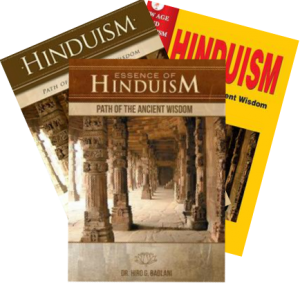Hindu Temple is the verily the foundation of Hinduism. For Hindus, visit to temples and Holy places (Tirtha Yatra) is one of the five essential spiritual practices (Panch-yajna). Along with reading the Holy Scriptures (Swadhya), uttering God’s name (Japa), worship (Puja), and performing rituals (Charya), visit to the temple is considered as a very necessary spiritual practice (Sadhana). A Hindu is ordained never to outgrow the temple; however high his or her spiritual journey has reached. Hindu continues to visit the temple—to pray, to worship, and to be divinely inspired—till the end of his or her life.
Hinduism is regarded as the oldest living religion of the world. This is because of its dynamic character; it has responded to the oncoming challenges with courage, confidence and wisdom. From the beginning, it has adopted and adjusted as per the demands of situations and circumstances. From the earliest period of the Vedas, changes came in succession through the Upanishads, the Bhagavad Gita, the Srimad Bhagavatam, and many other Holy writings. Dynamic character became visible, but no force or violence was deployed; the changes were made in subtle manner. The old were always revered and respected, although gently modified to suit the conditions of time and place.
Today it has been perhaps one of the greatest challenges for Hindus living outside of India to integrate and adapt themselves to different cultures, while at the same time retaining their own identity of religion and tradition. Hindus cannot afford to throw away their long-cherished heritage, but some useful changes may be needed periodically. Human evolution is a saga of such endeavors, where the good and worthy is accepted and the harmful and unworthy is dropped.
Hindu temples in US—majority of them have been built in the last few decades—are in the process of many changes to a varying degree individually. Few suggestions are submitted here for general consideration and discussion at suitable occasions. It is now felt that HMEC may be the best venue to take the responsibility to organize such discussions and convey the opinion of various religious leaders to all temples and Hindu community in general. The suggestions, which find favor with majority, may be then recommended as “Model Proposals”, without putting any pressure on individual temples to implement the same. From the very beginning, it has been the Hindu tradition Parampara that no force is ever used.
Suggestions for Hindu Temples USA:
• Law of the land. It is mandatory that all must obey the laws of the land. Hindu temples may take every precaution to see that no law is broken by any act of commission or omission. Hindu temple may indeed be a proper place to educate the community regarding many public laws.
• Account Keeping: Hindu temples often are found to be rather lax about account keeping; in the long run this may become a big liability in many different ways. Professional advice may be sought and meticulous account may be kept.
• General Hygiene of the Temple: Many of the Hindu temples need to pay attention to the general upkeep and hygiene. Special attention is needed for maintaining proper care of the rest rooms, which are often neglected.
• Sitting Arrangements: Hindu temples now have generally mixed arrangements for sitting on chairs and on floor. Floor sitting may be better organized so that there is no over-crowding. On special occasions, often devotees sit even in the gangway. In USA it is a rule to write the maximum number of occupants in any room. This rule may be properly enforced to avoid fire hazard and other problems. Some Buddhist temples arrange individual seating arrangements on the floor also; this method may be adopted in future.
• Language: Temple activities are generally conducted at present in mixed languages. English and Hindi or vernacular languages are used in mixed manner. The rituals are conducted in Sanskrit. Many Christian churches in the beginning used to conduct their activities in their respective European languages like German, French, and Spanish etc. Later on all have adopted English in general. Hindu temples may seriously consider the use of English more and more so that all devotees may understand the proceedings. Hindu temples are often visited by mixed crowds of different Indian languages. Youth and children, who are not well versed in Indian languages, often feel lost when the announcements are made in Indian languages. Ignoring the basic needs of the youth and children may prove to be very costly; they may feel alienated and avoid attending the temple altogether. Most seniors on the other hand have increasingly fair knowledge of English now and would not mind the change over if they are explained properly. On the other hand, sometimes the language issue is unnecessarily made a sentimental topic. Children especially are pushed to learn the vernacular languages by emotional pressure. We may look at the problem by long foresight and be more practical. It is hard to imagine that Hindu children, after one hundred years from now, will understand many vernacular Indian languages despite all our efforts! Sometimes we become blocked in time when we left India without realizing that many changes are taking place in India currently. India has now become the number one English speaking country of the world. English is no more a foreign thing for Hindus. Adopting it in more meaningful and graceful way will be rather a mature decision.
• Rituals: There have been big discussions regarding rituals in Hindu theology. All have pointed toward discouraging what is termed as ‘empty rituals’, thereby meaning rituals without understanding the meaning and not making use of the same in practical life. The rituals may be performed in more simplified manner: The ritual steps are made available to the devotees on printed pamphlets. The Sanskrit sloka are printed both in original Sanskrit and Roman script. Meaning of the sloka is printed in English. As the priest chants the sloka, he explains the meaning of each step. This may also be read on the pamphlet distributed. Un-necessary repetition is avoided. The importance of the sloka in everyday life is emphasized by the priest, thus making the ritual of practical importance.
• Havan Kund: This worship ceremony seems to be getting more popular in USA. There is however need to modify it so that there is minimal smoke and fire as per the laws. Smoke in a closed room may be quite harmful, especially for those who are suffering from heart or lung problems. Often there is lot of wastage of milk, ghee, and other precious materials in this ceremony. Symbolic mini offerings may be substituted, and instead other useful articles may be collected in the form of canned foods etc. to be later sent to some nearby homeless or poor centers.
• Children Classes: Many Hindu temples now offer Bal-vihar classes for children. This imparts basic knowledge of Hindu religion and culture to the children. Even so the classes may especially concentrate on imparting coaching in proper good conduct sada-achar–they may be taught how they should behave with elders, with members of the family in the home and with others outside–instead of learning more complicated things like chanting slokas and mantras. At their age, good conduct ought to be the priority training. Good conduct (Yamas and Niyamas) may later become the pillar on which the edifice of religion can be built erect and strong.
• Social Service: Hindu temples may gear to take projects like Support Groups in different categories like youth, adults, women in distress, seniors, sick persons etc. American Christian churches often offer well organized services for various social groups. Professional help of various devotee members like doctors, psychiatrists, etc may be solicited for this purpose.
In India, many temples are involved in charitable projects like medical service, food for poor, drinking water projects etc. Hindu temples in USA may also start taking interest in similar projects here, both for deserving local Hindu community as well as for other communities in the neighborhood. This may create enormous goodwill. Often there is antagonism and prejudice amongst communities for different reasons. Doing a good deed is the proper way to deal with such negative developments and instead create a positive good relationship. Hindus have always believed in the philosophy of world as one divine family vasudhaiva kutumbkam.
• Priest/Swami:
There is a need to keep an eye on the general behavior of the priest/swami in Hindu temple. They too are human beings and therefore are vulnerable to make mistakes. Recent sex scandals of the Catholic churches may make us more vigilant that similar problems do not occur in Hindu temples also. Unfortunately some cases have already happened in USA as well as other countries including India. Remaining in denial is not a correct solution. The penalties are high, both for the person who commits the sexual offences and for the institutes and temples where these offenses take place, especially when minors are involved. Millions of dollars may be fined, resulting in bankruptcy and avoidable embarrassment.
There is already a chronic shortage of Hindu priests in USA and other foreign countries. It is only likely to become more severe in years to come. Many Brahmin youths now opt for careers other than conducting religious ceremonies. As such the need for the non- Brahmins and lay persons to offer a helping hand is obvious. A short manual may be prepared under the auspices of HMEC USA, which contains different ceremonies, written in English, with Sanskrit slokas written both in Sanskrit and Roman script, so that more persons can use the manual. A small course also may be offered to house-holders (with aptitude), who may conduct these ceremonies when necessary, on voluntary basis only. Donations however may be accepted only toward the temple, rather than the individual volunteers, whenever such voluntary services are offered. These volunteers may not be encouraged to become professional in this category. In some remote places, even today, it is impossible to get the regular priest to conduct some ceremonies. This alternative may offer a good solution. Some priests are also known to charge exorbitant fees (Dakshina) for performing the ceremonies. The volunteer service of conducting the pujas may thus help people who cannot or do not want to pay so much money.
• Youth Involvement: There is need to involve the youth in the temple activities. Often they shy away, especially when they are not encouraged. Worse still unfortunately they are even discouraged, when they make one or two mistakes. Their participation is rather essential; they are our leaders of tomorrow. In many Hindu temples, very aged senior persons hold the important posts, almost indefinitely. Certain executive committee posts may be earmarked for the youth, and they may be given a free hand to fulfill their responsibility; we may trust them, and stand by them through thick and thin. Antagonism between the old and the young is not a very welcome situation. The final responsibility lies with the seniors, who are more mature and wise. The suggestions put forward by the young may be taken with utmost seriousness and implemented as far as possible; this is the only way the youth will involve themselves.
• Shoes Arrangement: Shoes arrangement in Hindu temples has been often an eye sore. Earlier some efforts have been made to allow the shoes inside the temple, fully or partly. It appears reasonable that the shoes may not be allowed in the main temple, where the murtis are placed. However wearing the shoes in other rooms and in the main auditorium also has remained rather controversial. Even so it is highly advisable to make proper arrangements to keep the shoes inside the temple rather than on the street. There should be some chairs so that persons may remove or put on the shoes comfortably sitting, rather than managing the same in awkwardly and uncomfortable standing position. After removing the shoes, one may not have to walk on cold, wet or rough and uneven surface. It may not be known to many temple organizers that the diabetic patients are forbidden to walk bare foot even in home lest they may hurt their feet and then run into some serious complications. A judicious attention to this matter may help to find good solution to this problem.
• Sharing of Authority and Responsibility: Hindu temple is essentially a religious place. Some organizational arrangement often invites politics. The senior office bearers who have spiritual attitude may defuse the confrontations and arguments effectively. They may do well to recall the old decree of Mahabharat: Tasmat tikshnataram mridu— “By gentleness one can overcome the greatest difficulty in the world.” In a religious place of temple, it is rather unbecoming to resort to quarrels and arguments; we may always handle the temple matters gently by sharing all the authority and responsibility. Those who are more stiff and egoistic may not be encouraged to serve on the temple committee posts till they have resolved their own temperamental issues like anger etc.
• Inter-racial Marriages: By recent estimate, as many as one third of marriages in USA Hindu community are likely to be inter-racial and inter-religious. This ratio may increase even further in the future. It is therefore important to gear our temples to receive and welcome the non-Hindu spouses. Ignoring or despising them just because they are not Hindus may become damaging. We may in fact close the doors to the entire family and the generations to follow with such attitude. Instead we may be more positive, accommodating, and practical in our approach. We must remember that once we have opted to make America our new home, we may adopt its ways and manners gracefully rather than expect others to adapt to ours!
• Tirtha-yatra USA: Earlier (Mandir Vani-Sept 2009), I had submitted a proposal to organize Tirtha-yatra USA. HMEC may consider this proposal for discussion, and take steps to implement the proposal. There are now over 800 Hindu temples in USA and Canada—some of them very grand and full of spiritual vibrations. For Hindus, visiting temples, especially in the later period of life before the death, is considered as very auspicious and essential for moksha salvation. Even for the younger persons, Tirtha-yatra may be properly combined with other sight-seeing tours to make them more attractive. There is big scope for exploring and implementing this project along with some reputed tour companies in future—both commercially, but of course much more spiritually.
• Spread Goodwill: Often Hindu leaders have been talking in negative manner regarding relationship with the mainstream society of America. This only creates prejudice and ill will. Hindu temples will do well to spread goodwill and friendship. Hindu temples across the country may also initiate some projects of service to the poor and needy in their neighborhoods, irrespective of race and religion. In the long run, these good gestures pay very big dividends. Nearly three million Hindus are now living in USA. Their future generations too will live and build their dreams here in this land. Even so, Hindus will continue to be less than 1% population of the country. It is most important to live in peace and harmony. Hindu temples may play a vital role in building the bridges and demolishing the prejudice and hatred.
(Dr Hiro Badlani is the author of Hinduism: Path of the Ancient Wisdom www.hinduismpath.com. He lives at Los Angeles and can be contacted at hirobadlani@gmail.com).










